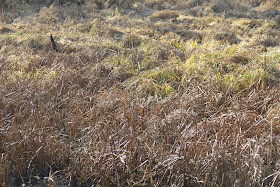You probably notice that it looks messy. Many gardeners could not stand to leave a garden looking like this through the winter. I am not one of them. For years I cleaned my garden beds each fall and removed all of the dead material. I stopped doing this about the time I started planting mostly native plants in the garden.
Why do I leave the garden looking like this?
To sum it up in one word - habitat.
 |
| Monarch Waystation #6591 |
I want the garden to be a year round habitat for native species. The garden is certified as a Monarch Waystation, but it also provides habitat to dozens of other invertebrate species including native bees.
 |
| Bee hotel at almost full capacity - all the capped holes are full of larval bees |
Many of the bees inhabit the native bee nesting blocks. Others will spend the winter hidden in the hollow stems of dead plants - a great reason to leave plants standing over the winter. Other insect species spend the winter hidden in the carpet of dead leaves and other debris that I leave in the garden.
 |
| Look at all the potential hibernation locations! |
Seeds are another major reason that I leaves the garden alone in the fall. I want as little open space in the garden as possible - open spaces allow weeds to pop up, full spaces have no room for weeds. I want the garden to be full of native plants, but fully grown plants can be expensive to purchase. If I leave all the old flower stalks in place through the winter, the garden replants itself.
 |
| Showy Goldenrod seeds ready to deploy into the garden |
 |
| Cup Plant seeds are on the menu for many birds |
While I don't pretend that my garden is a complete habitat, it does help. That's all that I can ask it do do in the limited amount of space that I have available. By treating the garden as habitat I see more species of animals (especially insects) than I would if I treated the garden as an outdoor extension of the home that needs to be kept neat and clean. In the long run, I think the garden is healthier than it would be if I constantly felt the need to tame it.
The garden gives back with a series of delights throughout the year.
 |
| American Highbush Cranberry fruit |
It also provides surprises.
 |
| A Wild Strawberry bloom in late November! I found several of them. |
In the spring, before the plants begin to grow, I can remove all of the old stems and add them to the top of my compost pile. (Don't worry any bee larvae will have the opportunity to emerge from the stems.) The leaves and other debris will decompose naturally on the ground, acting as a natural mulch and helping to rebuild the soil. New plants will pop up from the seeds that spread throughout the garden. Some will be allowed to grow in place; others will be transplanted within the garden or planted in other gardens.
I like my messy fall garden. I think I'll keep it.












































